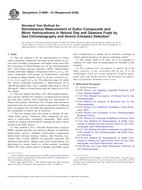Potrebujeme váš súhlas na využitie jednotlivých dát, aby sa vám okrem iného mohli ukazovať informácie týkajúce sa vašich záujmov. Súhlas udelíte kliknutím na tlačidlo „OK“.
ASTM D6968-03(2009)
Standard Test Method for Simultaneous Measurement of Sulfur Compounds and Minor Hydrocarbons in Natural Gas and Gaseous Fuels by Gas Chromatography and Atomic Emission Detection
Automaticky preložený názov:
Štandardná skúšobná metóda pre súčasné meranie zlúčenín síry a maloletých uhľovodíkov so zemným plynom a plynných palív plynovou chromatografiou a atómovou detekcie emisné
NORMA vydaná dňa 1.6.2009
Informácie o norme:
Označenie normy: ASTM D6968-03(2009)
Poznámka: NEPLATNÁ
Dátum vydania normy: 1.6.2009
Kód tovaru: NS-37142
Počet strán: 7
Približná hmotnosť: 21 g (0.05 libier)
Krajina: Americká technická norma
Kategória: Technické normy ASTM
Anotácia textu normy ASTM D6968-03(2009) :
Keywords:
atomic emission detection, extended gas analysis, gas chromatography, hydrocarbons, odorants, sulfur compounds, total sulfur, Atomic emission detection, Extended gas analysis, Gas chromatography (GC)--petroleum products, Gaseous fuels, Hydrocarbons, Natural gas service systems, Odorants, Simultaneous measurement/determination, Sulfur compounds, ICS Number Code 71.040.50 (Physicochemical methods of analysis), 75.160.30 (Gaseous fuels)
Doplňujúce informácie
| Significance and Use | ||||||||||||||||||||
|
Gaseous fuels, such as natural gas, petroleum gases and bio-gases, contain varying amounts and types of sulfur compounds. They are generally odorous, corrosive to equipment, and can inhibit or destroy catalysts employed in gas processing. Their accurate measurement is essential to gas processing, operation and utilization, and may be of regulatory interest. Small amounts (typically, 1 to 4 ppmv) of sulfur odorants are added to natural gas and other fuel gases for safety purposes. Some sulfur odorants can be reactive, and may be oxidized, forming more stable sulfur compounds having lower odor thresholds. These gaseous fuels are analyzed for sulfur odorants to help in monitoring and to ensure appropriate odorant levels for public safety. This method offers a technique to determine individual sulfur species in gaseous fuel and the total sulfur content by calculation. Gas chromatography is commonly and extensively used to determine all components in gaseous fuels including fixed gas and organic components (Test Methods D 1945 and D 1946). Major components measured are often used for the determination of gas property, such as heating value and relative density. Higher molar mass hydrocarbons are of interest even when present in small amounts because their larger impact on heating value, hydrocarbon dew point and gas quality relating to gas operation, gas utilization and environmental impacts. |
||||||||||||||||||||
| 1. Scope | ||||||||||||||||||||
|
1.1 This test method is for the determination of volatile sulfur-containing compounds and minor hydrocarbons in gaseous fuels including components with higher molar mass than that of propane in a high methane gas, by gas chromatography (GC) and atomic emission detection (AED). Hydrocarbons include individual aliphatic components from C4 to C6, aromatic components and groups of hydrocarbons classified according to carbon numbers up to C12 at least, such as C6-C7, C7-C8, C8-C9 and C9-C10, etc. The detection range for sulfur and carbon containing compounds is approximately 20 to 100 000 picograms (pg). This is roughly equivalent to 0.04 to 200 mg/m3 sulfur or carbon based upon the analysis of a 0.25 mL sample. 1.2 This test method describes a GC-AED method employing a specific capillary GC column as an illustration for natural gas and other gaseous fuel containing low percentages of ethane and propane. Alternative GC columns and instrument parameters may be used in this analysis optimized for different types of gaseous fuel, provided that appropriate separation of the compounds of interest can be achieved. 1.3 This test method does not intend to identify all individual sulfur species. Unknown sulfur compounds are measured as mono-sulfur containing compounds. Total sulfur content of a sample can be found by summing up sulfur content present in all sulfur species. 1.4 This method is not a Detailed Hydrocarbon Analysis (DHA) method and does not intend to identify all individual hydrocarbon species. Aliphatic hydrocarbon components lighter than n-hexane, benzene, toluene, ethyl benzene, m,p-xylenes and o-xylene (BTEX) are generally separated and identified individually. Higher molar mass hydrocarbons are determined as groups based on carbon number, excluding BTEX. The total carbon content of propane and higher molar mass components in a sample can be found by summing up carbon content present in all species containing carbon. 1.5 The values stated in SI units are to be regarded as standard. No other units of measurement are included in this standard. 1.6 This standard does not purport to address all of the safety concerns, if any, associated with its use. It is the responsibility of the user of this standard to establish appropriate safety and health practices and determine the applicability of regulatory limitations prior to use. |
||||||||||||||||||||
| 2. Referenced Documents | ||||||||||||||||||||
|
Odporúčame:
EviZak - všetky zákony vrátane ich evidencie na jednom mieste
Poskytovanie aktuálnych informácií o legislatívnych predpisoch vyhlásených v Zbierke zákonov od roku 1945.
Aktualizácia 2x v mesiaci !
Chcete vedieť viac informácii ? Pozrite sa na túto stránku.




 Cookies
Cookies
